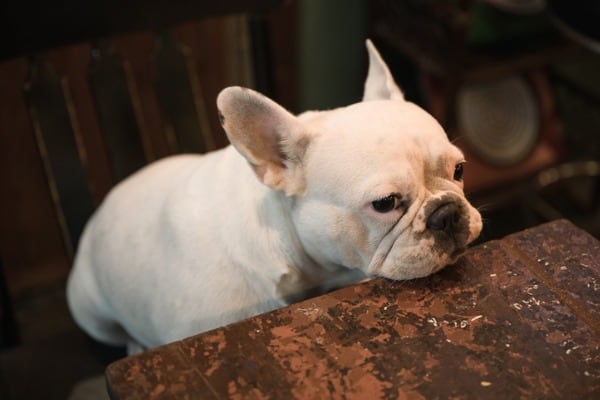
Coffee tables, bookcases, and chairs – these are places most pets aren’t allowed to play on. Yet, sometimes, that temptation is too strong for an adventurous dog or cat.
Your pet using your home furnishings for their personal playground is a little irritating, but it’s even worse if they have an accident and leave a urine stain on wood furniture.
Cleaning pet stains from wood surfaces can seem daunting.
Don’t worry:
You absolutely can get dog urine out of wood furniture.
It might seem like a complicated problem, but with just a few supplies and a good cleaner (more on this below!), you’ll be able to solve this stinky problem.
Household cleaning products like baking soda and white vinegar can be a lifesaver to get you started. But do stay away from dishwashing liquid (dish soap) and harsh cleaning products.
But what you really need to turn to is a powerful product known as enzyme cleaner – simply the most effective dog urine stain remover; and the right one safe for wood products.
If you’ve ever had to remove a pet urine stain from the floor, such as a hardwood floor or even below the subfloor, then you know the challenge ahead.
Good news.
It’s not much different than getting stains out of wood furniture.
How to Get Dog Urine Out of Wood Furniture: Step-by-Step
There are a few steps, but it’s not an overly complex task.
What if you have a cat?
The methods listed here work just as well if you’re wondering how to get cat pee smells out as well.
Step 1: Wipe it up
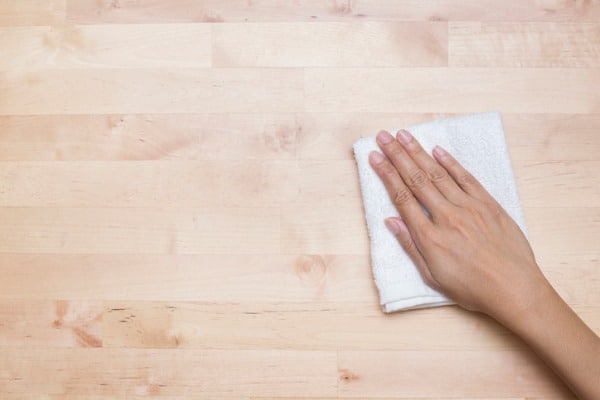
You’ll need to clean up any excess liquids before you treat the wood surface. A microfiber cloth will work great.
The sooner you do this vital step, the less chance the urine will have to soak into the wood.
Wood that has been treated or sealed can have an added layer of protection against liquid, but you should still clean the surface to banish any ammonia smell from the pee’s uric acid left behind.
Make sure you have thoroughly soaked up the urine before going to the cleaning phase.
I’ve found old towels to be the best for the job – paper towels don’t hold much liquid, and you’ll use a lot of them.
Step 2: Treat with an Enzyme Cleaner
Enzyme cleaners can work on many surfaces, from helping remove urine on carpets to plastic kennel trays.
What’s so great about enzymes?
They attack and destroy dog urine stains at the source. A true, natural urine removal remedy.
The natural, living bacteria eat and break down the stinky particles that leave behind unpleasant scents and stains.
Instead of masking the smell, enzymatic cleaners act as a urine removal solution and rid the issue altogether.
Our favorite commercial product for wood furniture? Rocco & Roxie Professional Strength Stain and Odor Remover.
It is advised to do a spot test on wood furniture before treating the whole area. Some wood will warp, swell, or react to water sprays.
Rocco and Roxie suggest testing in a hidden spot and then blotting (and not scrubbing) with a white or light-colored microfiber cloth. Do this, especially on surfaces with a dark stain finish.
If you see color on the cloth in the shade or hue of your wood stain, this solution might not be safe to use.
You might be concerned about how your furniture responds to enzyme cleaner, which is understandable.
There’s an alternative – I’ll go over that soon.
If you have a green light to move forward with using an enzyme cleaner, the job is quite easy.
Step 3: Let it Set
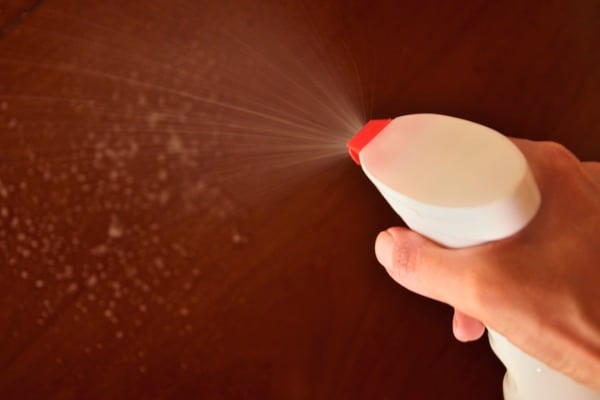
For simple surface urine stains, Rocco and Roxie Odor Remover can be sprayed on the area and left for 5-10 minutes.
Usually, the longer, the better, but in the case of wooden furniture, we don’t want to press our luck with leaving the liquid setting for too long.
You can let it sit for up to 10 minutes before removing it, then repeat this process several times.
Blot up the excess liquid, and allow the area to dry.
A deep stain might need more product and definitely needs more time for the cleaner to kick out the organic stain (but again, not too long, depending on the wood).
If you can, you’ll need to let it set for at least an hour before wiping away the excess.
Remember that older stains, especially, can take more than one round of enzyme treatment before they’re entirely gone.
When Enzyme Cleaners Aren’t an Option
There are a few cases when using enzymes might not be the best choice.
In particular, antique furniture must be handled with extra special care.
In this case, you can try some wood-appropriate products or homemade cleaner solutions. These may only decrease visual stains and urine odors, but it’ll still be worth the effort.
As always, clean up the fresh urine before you move on to treating the furniture.
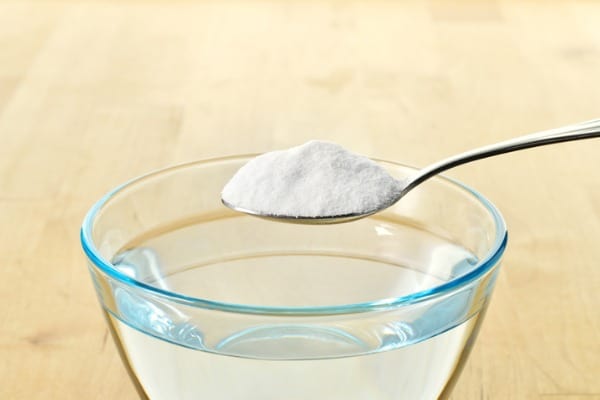
Baking soda
I recommend using baking soda if you’re dealing with unfinished wood on a delicate wooden piece.
Sprinkling it over the entire affected area will draw out moisture and give your wood a fighting chance.
For this to work, you’ll need to coat the entire spot in a layer of baking soda. Be liberal with it – make sure the coating is enough that you don’t see any wood underneath it.
Allow it to sit on the spot for several hours. The excess can be vacuumed up.
Try equal parts vinegar + water
A cleaning solution of equal part vinegar and equal parts water can help neutralize smells while still being gentle on surfaces.
As with other liquid treatments or even clean water, I don’t recommend using a vinegar solution on unfinished wood – meaning wood that hasn’t been sealed with polyurethane or a similar sealant.
Why not?
Water or even just too much moisture soaked into wood can ruin it. If your surfaces are already sealed, odds are no urine managed to soak too far into the wood itself.
So in this scenario, a gentle vinegar and warm water solution can decrease or even eliminate dog urine smells in the wood.
It’s best to spray the vinegar mix out of a spray bottle, but you can carefully pour enough to cover where the urine is.
Depending on the wood and finish, I would recommend only a light scrub; otherwise, you can let it sit for a few minutes before wiping it up and allowing the area to dry.
What about Hydrogen Peroxide?
This is your grandmother’s recipe, and it can help, but in most cases will not be the end-all solution.
You can combine a 3% strength hydrogen peroxide bottle and 3 tablespoons of fresh baking soda. Then mix in no more than 3 drops of dish soap.
The soap is meant to help pick up the urine to a degree, so it’s important to use Dawn since this is the only dishwashing liquid that won’t leave behind a residue surfactant (the sticky stuff).
Oil Soap to the rescue?

A treatment made for wood, such as oil soap, is a safe way to help fix spots and stains.
I highly recommend something with orange oil, like Howard Orange Oil Wood Polish.
The natural oils go a long way in combating any strong odor – and the citrus smell can help discourage your pet from urinating in the spot again.
Preventing Future Offenses
When your household possessions fall victim to a pet accident, the resulting cleanup makes you want to avoid it altogether.
A lot of furniture accidents occur from male pets marking territory.
So, for example, if you have an unneutered cat, you might need to know how to get cat urine out of wood furniture.
But what about keeping the problem from recurring?
Repel the pets
Repel isn’t a word we often associate with our beloved fur children. But when they’re disrespecting house rules, sometimes we need to take measures to protect our belongings.
There are many safe, humane ways to keep your pet off of certain surfaces.
Cats especially are known for roaming across tables, counters, and other furniture we’d rather not have them walking on.
Most of these options for deterring them can be used on any surface, including wood.
Aluminum foil
The feel and sound of tin foil under a cat’s paws is often enough to send the message: you’re not allowed here.
See this cat’s reaction if you’re skeptical.
Sonic devices
You can purchase a mat designed for the couch or other furniture, which will spook your pet just enough to uninvite them from certain places.
If you’ve ever had to get dog urine out of the couch, you’ll know a device like this could save you lots of headaches!
I am not recommending shock mats, which deliver a small electric shock upon contact (similar to how shock collars work).
These are inhumane and can cause anxiety and fear issues in pets.
Sonic mats emit a sound intended to shoo your pet from furniture without causing any pain. It’s usually a short, high-pitched noise or a belligerent beep that “scolds” them off the furniture.
As you can tell from the video, it’s enough to send the dog off the couch. Placing one of these mats on a coffee table would be just as effective.
Seal your furniture – seal off your rooms
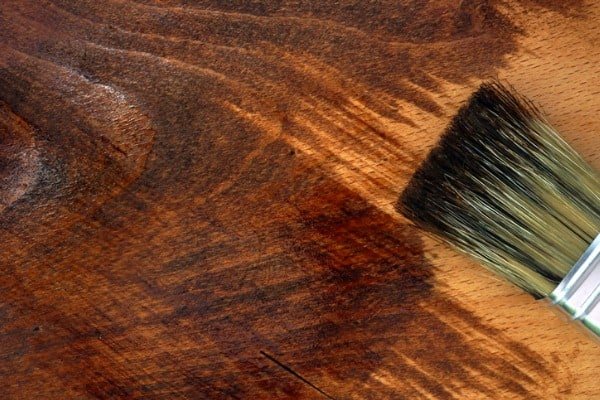
If you have a male pet with a spraying issue, it’ll be tough to protect some types of furniture – like bookcases.
It’s best to have a waterproof sealant on all of your valuable furniture.
What if your wood can’t be waterproofed?
Restrict access to the rooms where you keep your favorite pieces.
Male pets marking their territory can be attracted to the same areas repeatedly.
The more incidents that occur in the same spot, the harder it will be to eliminate the stain.
What about other issues?
Of course, if your pooch has accidents due to other problems such as leaking urine while lying down or another type of behavioral problem where they won’t go outside to pee, then, by all means, address these issues…for your dog’s sake, and the items in your house!
Use a belly band
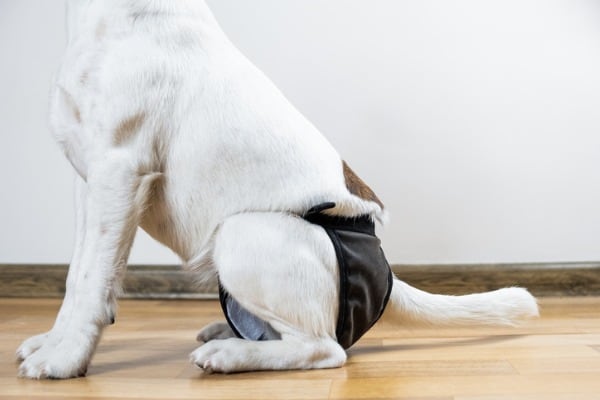
As a last resort, you can use a belly band on your male pet, who has a thing for spraying your furniture.
These are intended to be used similarly to diapers – they don’t stop your dog or cat from urinating, but they keep the urine off of your furniture and flooring.
Be sure to use it with care and watch out for urine scald in dogs – yep, it’s a real thing!
It may seem complicated, but it’s easier than dealing with accidents in the house.
Save the Trees
Wood doesn’t have to be scrapped after one pet urine accident.
To get pet urine out of wood furniture, you’ll need to be careful using any washing liquid or commercial product that can warp and damage it.
However, using enzymatic cleaners and household products can remove smells and stains.
Having one urine spot on wood is usually enough for pet parents to learn a valuable lesson – prevent it before it happens again.
There are several ways you can keep pets away from wood furniture. Even if they manage to be sneaky, the furniture can be salvaged.

